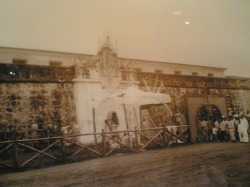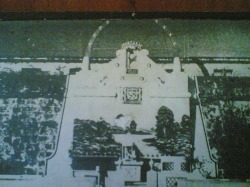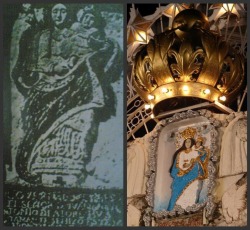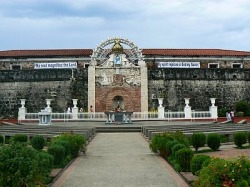Historical Background

The people of Zamboanga have a great devotion to the Blessed Mother, especially to La Virgen del Pilar, whose Image they venerate there.
Of the many inimitable lures and fascinating charms of Zamboanga, none can be compared to the miraculous Virgin of Pilar in the historic Fort.
So great is the fame of devotion to the Lady of the Fort that the annual celebration of her feast on October 12 has greatly outstripped the City's official feast day. This has made the Virgin of Pilar the actual patroness of Zamboanga City, instead of the Immaculate Conception whose feast is celebrated on December 8.
Of the many inimitable lures and fascinating charms of Zamboanga, none can be compared to the miraculous Virgin of Pilar in the historic Fort.
So great is the fame of devotion to the Lady of the Fort that the annual celebration of her feast on October 12 has greatly outstripped the City's official feast day. This has made the Virgin of Pilar the actual patroness of Zamboanga City, instead of the Immaculate Conception whose feast is celebrated on December 8.
The Fort

The embattled Spaniards built the Fort in 1635 as a secure bastion against the constant threats of fierce marauding warriors who were driven by a deep- seated hatred for the white invaders and colonizers, and to stop the Moros from constantly raiding the Christians coastal towns of Zamboanga and to protect the Jesuit Missions. The construction was directed by the Jesuit Father Melchor de Vera. The fort was known as ''The Fort of Saint Joseph'', and served the double purpose of a fortress and a penitentiary.
In 1662 the fort were abandoned by the Spanish garrisons which sailed for Manila to help defend that city from the threat of the powerful Chinese pirate Kuesing. The forts were totally destroyed in 1663 to prevent it from falling into the hands of the Moros.
The removal of the garrisons and the destruction of the forts led to the increase in Moro raids in Christian towns which resulted in loss of shipping, the death and capture of thousands the destruction of properties and the slow down of farming industry. To prevent such calamities the Government decided to rebuild the forts. The reconstruction began in 1718 and was finished on April 8th 1719, under the direction of another Jesuit Priest, in the same site where the former one stood.
After its reconstruction, the Fort was renamed the Real Fuerza de Nuestra Señora del Pilar de Zambaonga. It carried that name until 1899. Sometime before 1860 the side of the Fort where the statue was located, was converted into a permanent shrine. For this reason the main entrance was sealed.
In 1662 the fort were abandoned by the Spanish garrisons which sailed for Manila to help defend that city from the threat of the powerful Chinese pirate Kuesing. The forts were totally destroyed in 1663 to prevent it from falling into the hands of the Moros.
The removal of the garrisons and the destruction of the forts led to the increase in Moro raids in Christian towns which resulted in loss of shipping, the death and capture of thousands the destruction of properties and the slow down of farming industry. To prevent such calamities the Government decided to rebuild the forts. The reconstruction began in 1718 and was finished on April 8th 1719, under the direction of another Jesuit Priest, in the same site where the former one stood.
After its reconstruction, the Fort was renamed the Real Fuerza de Nuestra Señora del Pilar de Zambaonga. It carried that name until 1899. Sometime before 1860 the side of the Fort where the statue was located, was converted into a permanent shrine. For this reason the main entrance was sealed.
The Image of La Virgen del Pilar

The Marian Image honored in the Fort is a small replica of Our Lady copied from the original Nuestra Señora del Pilar in Saragossa, Spain. The Blessed Virgin is shown standing in a pillar, carrying the Child Jesus on her left arm, while she holds her cape around her with her right hand. She wears an Imperial Crown upon her head.
There are two inscriptions on the wall, the translation of which may interest the readers;
"Reigning the Spains his Catholic Majesty Philip V Emperor of the American new world and Governing these Philippine Islands the most illustrous Ferdinand Bustilo and Rueda Field Marshall and Captain General. This Royal Fort of Our Blessed Lady of Pilar of Zaragoza was established and reconstructed which was accomplished by the IIlustrous General Goria Padilla and Escalante on April 8, 1719."
The inscriptions below the image read as follows:
"Governing this Penitentiary Juan Antonio de la Torre Bustamante this frontspiece was built in January 1734."
Since then the presence of Nuestra Señora del Pilar at her shrine in the Fort has been watching over the City in a very special way.
There are two inscriptions on the wall, the translation of which may interest the readers;
"Reigning the Spains his Catholic Majesty Philip V Emperor of the American new world and Governing these Philippine Islands the most illustrous Ferdinand Bustilo and Rueda Field Marshall and Captain General. This Royal Fort of Our Blessed Lady of Pilar of Zaragoza was established and reconstructed which was accomplished by the IIlustrous General Goria Padilla and Escalante on April 8, 1719."
The inscriptions below the image read as follows:
"Governing this Penitentiary Juan Antonio de la Torre Bustamante this frontspiece was built in January 1734."
Since then the presence of Nuestra Señora del Pilar at her shrine in the Fort has been watching over the City in a very special way.
- During the 16th century, she also protected the entire town Zamboanga against the British invaders.
- According to tradition, Nuestra Señora had also on several occasions appeared before the Moros to repel their attacks and dissuade them form taking over the Fort.
- In 1719, Nuestra Señora was reported to have appeared to a sentinel stationed in the Fort.
- On a certain occasion according to one of these legends, an image of the Blessed Virgin was born in a religious procession to the forts. The main entrance was located on that side of the image is to be seen. While the services were in progress, the alarm was given that Moro forces were about to make an assault. The frightened congregation rushed and crowded inside the fort. Suddenly the entrance was closed and sealed with lime and stone. In the confusion the image was left alone outside on its bies. It was not be found, but at this times a roughly stone carved image was discovered above the entrance which was miraculously closed.
- The unexpected Victory over the English ships on January 21st 1798 won by a much inferior land forces was considered as a significant aid from the Patroness of the Fort. The revolt of the prisoners kept in the fort on September 15th 1872 that threatened a wholesale looting of the town was miraculously crushed by an unexplained turn of event.
- The quick suppression of the epidemics on 1897 was attributed to the intercession of the Blessed Virgin of Pilar.
- Likewise, in this same year on September 21st, there was a series a series of earthquakes of increasing violence which however failed to cause mush damage to lives and properties due to the same supernatural intercession.
- She is the same Mary standing in mid-air over the Basilan strait on September 21st 1897 as seen by many, according to those who saw the apparition she had her right hand raised to signal the on rushing waves to stop and thus saving the city from a tsunami.
- Again the legend goes, She appeared at midnight on August 16th 1976, when a killer quake and a tsunami threatened the City.
- A Lady, runs another legend, was making her way by the main entrance where a solider was on guard. The soldier halted her, and the ensuing dialogue took place. La Señora: '' Soldier on guard, dare you deny a pass to the dawn of the day? If you recognize Mary, why do you halt her?'' El Soldado: '' My Ladyship, Mother of my heart, i crave or your forgiveness. For i am a common soldier that abides by his duty.''

Today Fort Pilar is no longer a military outpost. It has become one of the principal Marian Shrines in Mindanao. It is also a center of religious pilgrimages.
Immediately after the liberation when there was already a certain degree of order and security Zamboanga hastened to the Fort Pilar on Saturday April 28, 1645, to offer a Mass of Thanksgiving and to sing the triumphant hymn of Te Deum. The joyful celebration on October 12, 1960 when the Image of Nuestra Señora La Virgen del Pilar de Zamboanga was canonically crowned.
The Shrine of Nuestra Señora La Virgen del Pilar is a unique in any aspects. To start with, it is an open- air shrine, without doors, right in the middle if the City. It is like a permanent invitation for all the Zamboangueños to come at any time of the day or night.
At sunset, when all the churches and chapels of the City are closed, many Zamboangeños from all walk of life are always seen at the Fort to pay a short visit to Our Lady, to pray, to light a candle, to pour out to her the daily joys and pains of their life. There is probably not a single day or night of the year when the Fort Pilar is found deserted, and these will continue while there is a Zamboangueño heart whose devotion and love for Nuestra Señora La Virgen del Pilar like unto the firmness of that historical Fortress that began Her Name and hold Her Sacred Image.
Immediately after the liberation when there was already a certain degree of order and security Zamboanga hastened to the Fort Pilar on Saturday April 28, 1645, to offer a Mass of Thanksgiving and to sing the triumphant hymn of Te Deum. The joyful celebration on October 12, 1960 when the Image of Nuestra Señora La Virgen del Pilar de Zamboanga was canonically crowned.
The Shrine of Nuestra Señora La Virgen del Pilar is a unique in any aspects. To start with, it is an open- air shrine, without doors, right in the middle if the City. It is like a permanent invitation for all the Zamboangueños to come at any time of the day or night.
At sunset, when all the churches and chapels of the City are closed, many Zamboangeños from all walk of life are always seen at the Fort to pay a short visit to Our Lady, to pray, to light a candle, to pour out to her the daily joys and pains of their life. There is probably not a single day or night of the year when the Fort Pilar is found deserted, and these will continue while there is a Zamboangueño heart whose devotion and love for Nuestra Señora La Virgen del Pilar like unto the firmness of that historical Fortress that began Her Name and hold Her Sacred Image.
